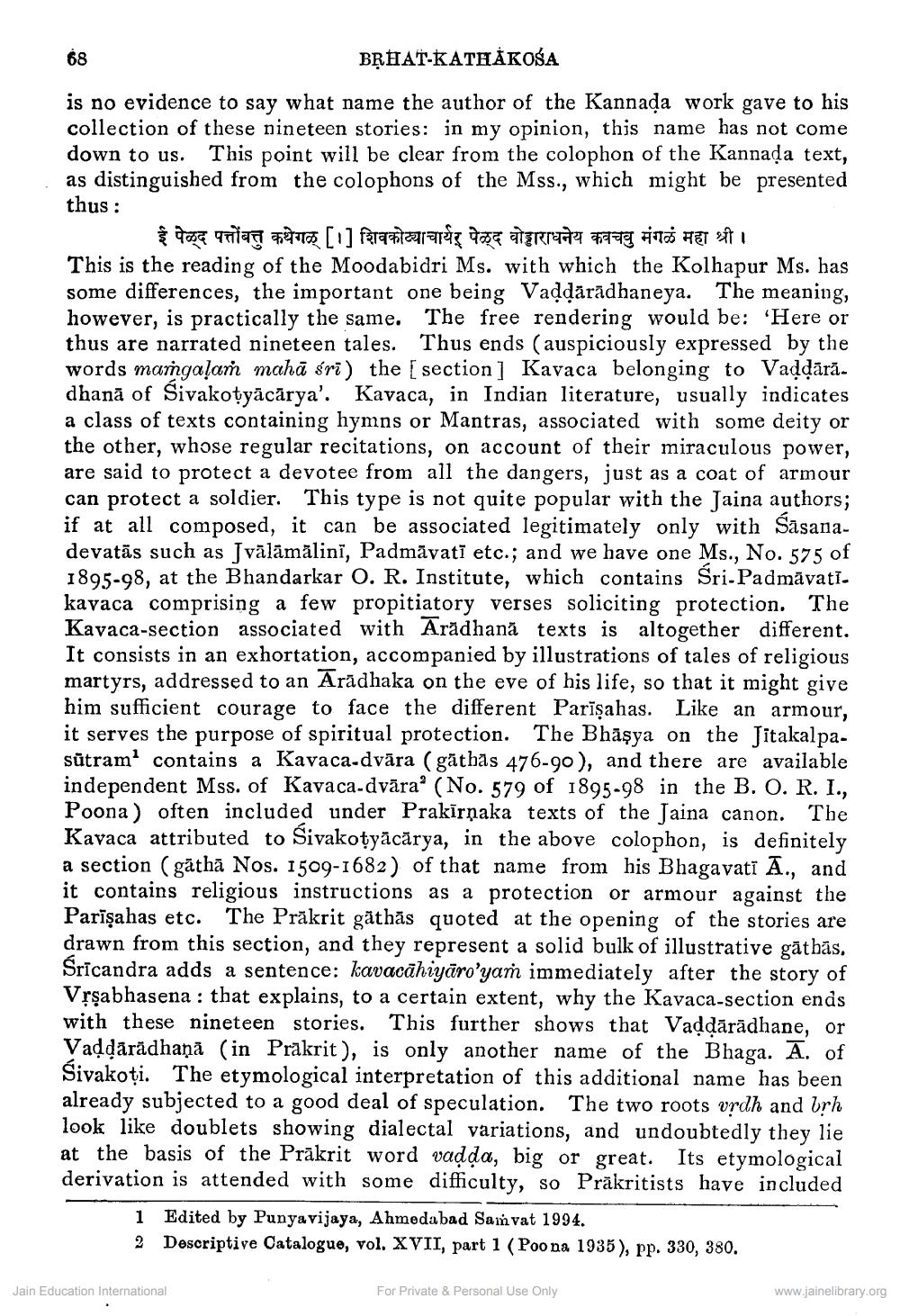________________
68
BRHAT-KATHÁKOŠA
is no evidence to say what name the author of the Kannada work gave to his collection of these nineteen stories: in my opinion, this name has not come down to us. This point will be clear from the colophon of the Kannada text, as distinguished from the colophons of the Mss., which might be presented thus :
ई पेळ्द पत्तोंबत्तु कथेगळ् [1] शिवकोट्याचार्यर् पेळ्द बोड्डाराधनेय कवचवु मंगळं महा श्री। This is the reading of the Moodabidri Ms. with which the Kolhapur Ms. has some differences, the important one being Vaddārādhaneya. The meaning, however, is practically the same. The free rendering would be: 'Here or thus are narrated nineteen tales. Thus ends (auspiciously expressed by the words mamgalaṁ mahā sri) the section] Kavaca belonging to Vaddāră. dhanā of Sivakotyācārya'. Kavaca, in Indian literature, usually indicates a class of texts containing hymns or Mantras, associated with some deity or the other, whose regular recitations, on account of their miraculous power, are said to protect a devotee from all the dangers, just as a coat of armour can protect a soldier. This type is not quite popular with the Jaina authors; if at all composed, it can be associated legitimately only with Sāsanadevatās such as svālāmālini, Padmavati etc.; and we have one Ms., No. 575 of 1895-98, at the Bhandarkar O. R. Institute, which contains Ári-Padmāvati. kavaca comprising a few propitiatory verses soliciting protection. The Kavaca-section associated with Aradhanā texts is altogether different. It consists in an exhortation, accompanied by illustrations of tales of religious martyrs, addressed to an Arādhaka on the eve of his life, so that it might give him sufficient courage to face the different Parīşahas. Like an armour, it serves the purpose of spiritual protection. The Bhāşya on the Jitakalpa. sūtram' contains a Kavaca-dvāra (gäthas 476-90), and there are available independent Mss. of Kavaca-dvāra' (No. 579 of 1895-98 in the B. O. R. I., Poona) often included under Prakīrnaka texts of the Jaina canon. The Kavaca attributed to Sivakotyäcārya, in the above colophon, is definitely a section (gäthā Nos. 1509-1682) of that name from his Bhagavati A., and it contains religious instructions as a protection or armour against the Parīşahas etc. The Präkrit găthās quoted at the opening of the stories are drawn from this section, and they represent a solid bulk of illustrative gāthās, Srīcandra adds a sentence: kavacāhiyāro'yam immediately after the story of Vrşabhasena : that explains, to a certain extent, why the Kavaca-section ends with these nineteen stories. This further shows that Vaddārādhane, or Vaddārādhaņā (in Prakrit), is only another name of the Bhaga. Ā. of Sivakoti. The etymological interpretation of this additional name has been already subjected to a good deal of speculation. The two roots urdh and brh look like doublets showing dialectal variations, and undoubtedly they lie at the basis of the Prākrit word vadda, big or great. Its etymological derivation is attended with some difficulty, so Prākritists have included
1 Edited by Punya vijaya, Ahmedabad Samvat 1994. 2 Descriptive Catalogue, vol. XVII, part 1 (Poona 1935), pp. 330, 380.
Jain Education International
For Private & Personal Use Only
www.jainelibrary.org




